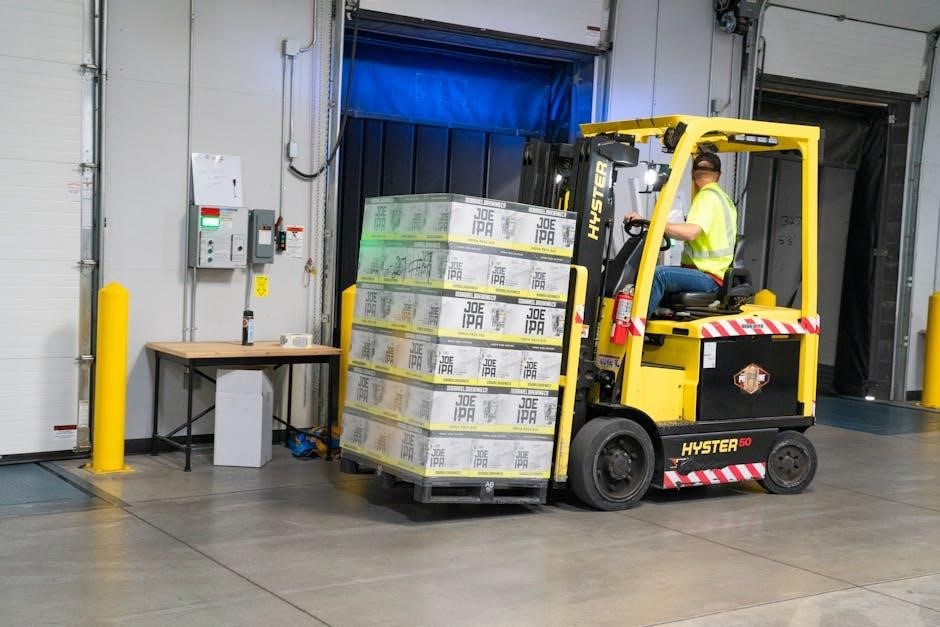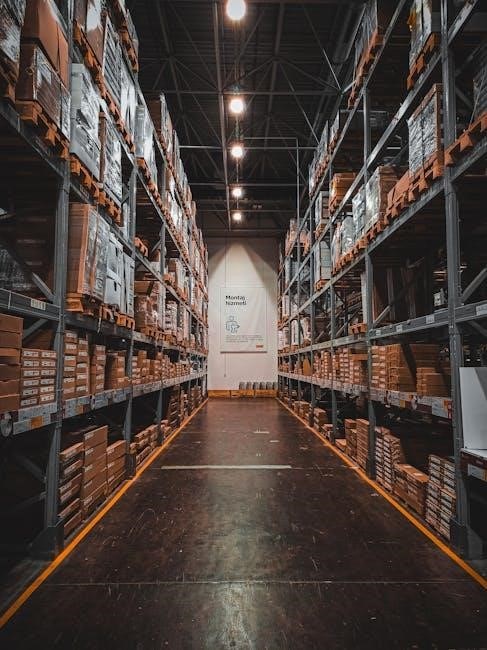
Pallet rack identification is crucial for ensuring safety, efficiency, and optimal warehouse operations. This guide helps users understand the basics of pallet racking systems and their components, enabling proper customization and maintenance to meet specific needs. Learn how to identify and select the right pallet rack for your storage requirements.
1.1 What is a Pallet Rack?
A pallet rack is a storage system designed to hold palletized goods in a structured manner within warehouses. It consists of vertical upright frames and horizontal beams that form bays to support pallets. Wire decks or shelves are often added for additional load support. Pallet racks are customizable to fit specific warehouse needs, ensuring efficient use of space and safe storage of materials. Proper identification of pallet rack components is essential for safety, maintenance, and operational efficiency, making it a cornerstone of effective warehouse management systems.
1.2 Importance of Pallet Rack Identification
Identifying pallet racks is vital for maintaining a safe and efficient warehouse environment. Proper identification ensures compliance with safety standards, prevents overloading, and aids in selecting the right components for specific needs. Key reasons include:
- Safety: Correct weight limits prevent structural damage and accidents.
- Compliance: Meets legal and industry regulations.
- Efficiency: Optimizes storage and workflow.
- Cost Savings: Avoids unnecessary expenses from incorrect purchases.
Accurate identification is essential for maximizing warehouse potential and ensuring operational safety.
1.3 Brief History of Pallet Racking Systems
The concept of pallet racking systems dates back to the early 20th century, evolving from basic storage solutions to sophisticated structures. The industrial revolution drove demand for efficient warehousing, leading to the development of standardized pallets and racking systems. Post-WWII, advancements in materials and manufacturing enabled mass production of pallet racks, making them a cornerstone of modern logistics. Today, pallet racking systems are integral to global supply chains, with continuous innovations improving safety, durability, and customization options to meet diverse storage needs.

Types of Pallet Racks
Pallet racks come in various designs to suit different storage needs. Common types include selective, double-deep, drive-in, cantilever, and pallet flow racks, each offering unique advantages.
2.1 Selective Pallet Racks
Selective pallet racks are the most common type of pallet racking system, offering easy access to every pallet. They consist of upright frames and horizontal beams, creating multiple storage levels. This design allows forklifts to access each pallet individually, ensuring high flexibility and efficient space utilization. Ideal for warehouses with varying stock sizes, selective racks are customizable to fit specific load requirements. Their simplicity and accessibility make them a popular choice for operations requiring frequent inventory turnover. They are also cost-effective and adaptable to different warehouse layouts.
2.2 Double-Deep Pallet Racks
Double-deep pallet racks are designed to store pallets two deep in each bay, maximizing vertical and horizontal space. They are ideal for warehouses with high storage demands, as they increase capacity while minimizing floor usage. These racks require specialized lift trucks, such as reach trucks, for loading and unloading. Double-deep systems are more space-efficient than selective racks but offer less accessibility to individual pallets. This configuration is best suited for facilities with consistent inventory turnover and the need for dense storage solutions.
2.3 Drive-In Pallet Racks
Drive-in pallet racks are designed for high-density storage, ideal for warehouses with limited space and large quantities of similar SKUs. Forklifts drive directly into the rack to load or retrieve pallets, guided by rails or channels. This system eliminates aisles between rows, maximizing storage capacity. Typically, drive-in racks are deeper and use upright frames and horizontal beams or rails instead of traditional beams. They are cost-effective for bulk storage but require careful forklift operation to avoid damage. Suitable for cold storage and high-turnover items, drive-in racks offer efficient space utilization while maintaining accessibility for specific inventory needs.
2.4 Cantilever Pallet Racks
Cantilever pallet racks are designed for storing long or irregularly shaped items, such as pipes, lumber, or furniture. They feature horizontal arms extending from vertical columns, creating an open layout without vertical obstructions. This design allows for easy access and flexible storage solutions. Cantilever racks are ideal for warehouses needing to accommodate non-standard pallet sizes or unique inventory shapes. They are available in single or double-sided configurations, offering versatility for various storage needs. Their durability and adaptability make them a popular choice for specific industrial applications.
2.5 Pallet Flow Racks
Pallet flow racks are high-density storage systems designed for efficient inventory management. They utilize gravity-fed lanes to move pallets from loading to picking faces, ensuring first-in, first-out inventory rotation. These racks are ideal for perishable goods and high-turnover items, as they minimize storage space while maximizing accessibility. Pallet flow systems are often used in distribution centers and manufacturing facilities, reducing the need for forklifts in tight spaces. By optimizing space and streamlining operations, pallet flow racks enhance warehouse efficiency and reduce handling costs. They are a cost-effective solution for businesses requiring rapid inventory turnover and organized storage systems.
Key Components of Pallet Racks
Pallet racks consist of upright frames, horizontal beams, wire decks, anchor bolts, and column protectors. These components ensure structural integrity and safe load handling in warehouses.
3.1 Upright Frames
Upright frames are the vertical structures in pallet racking systems, providing the main support for the rack’s stability and load capacity. Typically made from rolled steel, these frames are designed to withstand heavy loads and are a critical component in ensuring the safety and durability of the system. They feature pre-punched holes along their length for easy installation of horizontal beams and connectors. Proper alignment and secure anchoring of upright frames are essential to prevent collapse and maintain structural integrity. Safety features like column protectors are often added to shield frames from potential damage caused by forklift impacts or other warehouse equipment.
3.2 Horizontal Beams
Horizontal beams are critical structural components in pallet racking systems, providing support for pallets and connecting upright frames. These beams are typically made of steel and vary in size and strength based on the system’s design and load requirements. They are secured to upright frames using connectors, which can be clip-in or bolted. Proper installation and regular inspection of horizontal beams are essential to ensure safety and prevent damage. Their load-bearing capacity must align with the system’s specifications to maintain stability and functionality. Beams are customizable in length and thickness to suit different storage needs and warehouse environments.
3.3 Wire Decks
Wire decks are essential components in pallet racking systems, providing a stable surface for storing palletized goods. Typically made from durable wire mesh, these decks are placed on horizontal beams and come in various gauges and mesh sizes to accommodate different load requirements. Their open design allows for easy inspection and helps prevent the accumulation of dust and debris. Proper installation and regular maintenance of wire decks are crucial to ensure safety and optimal load distribution. They are versatile and can be customized to fit various pallet sizes and warehouse configurations, making them a key element in efficient storage solutions.
3.4 Anchor Bolts
Anchor bolts are essential for securing pallet racks to the floor, ensuring stability and preventing movement under load. They are typically made of durable materials like steel and are embedded into the concrete floor. Proper installation involves drilling precise holes and using epoxy or wedge anchors for a strong hold. Regular inspection of anchor bolts is critical to identify any loosening or damage. Tightening or replacing them promptly prevents potential safety hazards and maintains the structural integrity of the racking system. Always follow manufacturer guidelines for installation and maintenance to ensure optimal performance and safety.
3.5 Column Protectors
Column protectors are essential for safeguarding pallet rack uprights from damage caused by forklifts or heavy machinery. Made from durable materials like steel, these protectors are installed at the base of columns to absorb impacts, preventing dents or bends that could compromise the rack’s structural integrity. They are particularly important in high-traffic areas where collisions are more likely. Proper installation and regular inspections ensure column protectors remain effective, maintaining safety and extending the lifespan of the pallet racking system. Their presence is a critical component in preventing costly repairs and ensuring operational continuity.

Specifications of Pallet Racks
Pallet rack specifications vary based on weight capacity, height, and material, ensuring systems meet specific environmental and operational needs for safe and efficient storage solutions.
4.1 Height and Depth Considerations
Height and depth are critical factors in pallet rack design, ensuring optimal storage and accessibility. Rack height should align with warehouse ceiling clearance and forklift capabilities, maximizing vertical space while maintaining safety. Depth considerations vary based on pallet size and racking type, such as double-deep systems requiring specific forklifts. Proper measurements ensure efficient use of space, prevent overcrowding, and facilitate smooth operations. Always assess facility dimensions and equipment capabilities when determining rack height and depth to ensure compatibility and operational efficiency.
4.2 Weight Capacity and Load Limits
Understanding weight capacity and load limits is essential for safe and efficient pallet rack usage. These specifications ensure the system can handle the intended loads without risking structural integrity or safety. Weight capacity is typically determined by the design of the upright frames and horizontal beams, while load limits may vary based on the material and construction of the rack. Exceeding these limits can lead to damage or collapse, emphasizing the importance of proper planning and adherence to manufacturer guidelines. Always verify load limits before installing or adding storage to your pallet racking system.
4.3 Material and Construction
Pallet racks are typically constructed from steel, offering durability and strength. The material gauge and manufacturing process, such as roll-forming or welding, determine the rack’s load-bearing capacity. High-quality steel ensures resistance to wear and tear, while finishes like powder coating protect against corrosion. Proper construction methods, including bolted or welded frames, enhance stability and safety. The choice of material and construction directly impacts the rack’s performance, making it essential to select components suited to the intended use and environmental conditions.
4.4 Finish and Coatings
Finish and coatings play a vital role in enhancing the durability and appearance of pallet racks. Common finishes include powder coating, which provides a durable and corrosion-resistant surface, and hot-dip galvanizing for added rust protection. These coatings are applied to withstand harsh warehouse conditions, ensuring long-term performance. Additionally, some racks feature epoxy or enamel finishes for extra protection. Custom color options are also available to match branding or safety standards. Proper finishes and coatings not only extend the lifespan of pallet racks but also contribute to a clean and professional warehouse environment.

Best Practices for Pallet Rack Identification
Conduct regular visual inspections, read manufacturer labels, and verify load capacities to ensure safety and stability. Proper identification ensures optimal functionality and prevents potential hazards in warehouse operations.
5.1 Visual Inspection Techniques
Visual inspection is a critical first step in pallet rack identification and maintenance. It involves examining the uprights, beams, and connectors for signs of damage, wear, or misalignment. Look for rust, bends, or dents that could compromise structural integrity. Check all bolts and screws to ensure they are tightly secured and not loose. Verify that load-bearing components are undamaged and properly aligned. This process helps identify potential safety hazards and ensures the system operates efficiently. Regular visual checks are essential for maintaining safety and extending the lifespan of the pallet racking system.
5.2 Reading Manufacturer Labels
Reading manufacturer labels is essential for identifying pallet rack specifications and ensuring safe usage. These labels typically include weight capacity, load limits, and model numbers. Always verify the labels match your warehouse needs. Ignoring this step can lead to overloaded racks and potential hazards. Use the information to maintain compliance with safety standards and optimize storage efficiency. Regularly check for worn or missing labels and replace them if necessary. This practice ensures accurate identification and prolongs the lifespan of your pallet racking system.
5.3 Checking Load Capacity
Checking the load capacity of pallet racks ensures safe and efficient storage operations. Always verify the maximum weight limits specified by the manufacturer, as exceeding these can lead to structural failure. Inspect the rack for any visible damage or wear that might reduce its capacity. Use load charts or labels provided by the manufacturer to determine the permissible weight for each level. Regularly review and update load calculations to accommodate changes in inventory or rack configuration. This step is essential for maintaining safety standards and preventing potential accidents in the warehouse environment.
5.4 Inspecting Bolts and Connections
Inspecting bolts and connections is vital for ensuring the structural integrity of pallet racks. Start by checking all bolts for tightness and signs of wear or corrosion. Ensure they meet the manufacturer’s torque specifications. Look for loose connections, which can compromise safety and stability. Use a wrench or torque wrench to verify tightness without over-tightening. Replace any damaged or corroded bolts immediately. Pay attention to beam-to-upright connections, as they are critical load-bearing points. Regular inspections help prevent failures and ensure compliance with safety standards, maintaining a secure and reliable storage system. Always follow the manufacturer’s inspection guidelines for optimal results.

Maintenance of Pallet Racks
Regular maintenance ensures pallet racks remain stable and functional. This includes routine inspections, cleaning, lubricating moving parts, and promptly replacing damaged components to prevent accidents and extend lifespan.
6.1 Routine Inspection Checklists
Routine inspections are essential for maintaining pallet rack safety and efficiency. Start by checking uprights for damage or bending. Inspect beams for alignment and secure connections. Verify wire decks are properly placed and undamaged. Ensure anchor bolts are tightened and racks are plumb. Look for signs of wear on connectors and frames. Check load limits and ensure they are not exceeded. Document all findings and address any issues immediately. Regular checklists help prevent accidents and extend the lifespan of your pallet racking system.
6.2 Cleaning and Servicing
Regular cleaning and servicing are essential for maintaining pallet rack longevity and safety. Dust, debris, and grime can accumulate, hindering functionality and causing potential hazards. Use soft-bristle brushes or vacuum cleaners to remove dirt without damaging surfaces. Lubricate moving parts, such as rollers and hinges, to ensure smooth operation. Avoid using harsh chemicals that may weaken materials. Schedule periodic inspections to address wear and tear promptly. Proper servicing prevents corrosion and ensures load-bearing capacities remain intact, safeguarding both equipment and personnel.
6.3 Lubrication of Moving Parts
Regular lubrication of moving parts in pallet racks is essential for smooth operation and longevity. Components like rollers, hinges, and pivot points require periodic maintenance to reduce friction and wear. Use high-quality, water-resistant lubricants suitable for the specific material and environment. Check manufacturer recommendations for lubrication intervals to ensure optimal performance and prevent premature damage. Proper lubrication enhances efficiency, reduces noise, and minimizes the risk of mechanical failure, ensuring safe and reliable material handling. Schedule routine checks to maintain the integrity of all moving components.
6.4 Replacing Damaged Components
Replacing damaged components is essential for maintaining the structural integrity and safety of pallet racks. Regular inspections help identify worn or broken parts, such as bolts, beams, or uprights. When replacing components, ensure they match the manufacturer’s specifications to maintain load capacity and stability; Use approved tools and follow safety protocols to avoid further damage or accidents. Tightening all connections properly after replacement is crucial. Documenting the replacement process helps track maintenance history and ensures compliance with safety standards. Neglecting damaged components can lead to system failure, posing risks to personnel and inventory.

Safety Considerations
Ensure load limits are adhered to, and racks are properly installed and maintained. Regular inspections and staff training are essential for preventing accidents and ensuring safe operations.
7.1 Load Limits and Safety Margins
Load limits and safety margins are critical for ensuring pallet rack stability and preventing structural failure. Each system is designed with specific weight capacities, considering factors like beam strength, upright frame durability, and material quality. Exceeding these limits can lead to collapse, posing serious safety risks. Always refer to manufacturer guidelines and conduct regular inspections to verify load limits. Safety margins should be maintained to account for uneven distribution or unexpected stress. Proper adherence to these guidelines ensures operational safety and extends the lifespan of the pallet racking system.
7.2 Proper Clearances and Aisles
Proper clearances and aisle dimensions are essential for safe and efficient warehouse operations. Aisles must be wide enough to accommodate forklifts and pallets, typically ranging from 8 to 12 feet, depending on equipment size. Narrow aisles are used for high-density storage but require specialized lift trucks. Clearances around racks prevent collisions and ensure easy access for maintenance. Proper aisle layout also enhances workflow and reduces congestion. Ensuring adequate clearances and appropriately sized aisles is critical for compliance with safety standards and fire codes, while also optimizing warehouse productivity and operational efficiency.
7.3 Rack Protection Measures
To safeguard pallet racks from damage, implement protective measures such as column protectors and guardrails. Install safety nets to prevent items from falling and causing injuries. Regular inspections ensure structural integrity, while proper training minimizes accidental collisions. Use durable materials for protectors and ensure they are securely fastened. Clear signage in high-traffic areas alerts workers to potential hazards. These measures enhance workplace safety and prolong rack lifespan.
7.4 Training for Safe Operation
Proper training is essential for ensuring the safe operation of pallet racking systems. Warehouse staff should be educated on load limits, proper handling techniques, and safety protocols to prevent accidents. Regular training updates and adherence to safety standards are crucial for maintaining a secure working environment.

Customization Options
Customization options for pallet racks include configuring bay layouts, integrating accessories, color coding, and anchoring systems to meet specific warehouse needs and enhance functionality efficiently.
8.1 Configuring Bay Layouts
Configuring bay layouts is essential for optimizing warehouse space and efficiency. Each bay can be tailored to accommodate specific pallet sizes and weights, ensuring maximum storage capacity. By adjusting the height, depth, and beam levels, businesses can customize the layout to fit their inventory needs. Proper bay configuration also enhances accessibility, reducing congestion in aisles. Additionally, it allows for seamless integration of forklift operations, improving overall workflow. A well-planned bay layout maximizes safety and operational efficiency, making it a critical aspect of pallet rack system design and implementation.
8.2 Integrating Accessories
Integrating accessories into pallet racking systems enhances functionality and customization. Common accessories include wire decks, column protectors, and pallet supports, which improve safety and load stability. Dividers and bin boxes help organize smaller items, while shelving and step beams accommodate varied storage needs. Protective components like guardrails and safety nets prevent damage and accidents. These additions tailor the racking system to specific operational requirements, ensuring efficient use of space and optimizing workflow. Properly selecting and installing accessories is key to maximizing the system’s performance and longevity.
8.3 Color Coding for Organization
Color coding is a versatile tool for organizing pallet racks, enhancing efficiency and safety. By assigning specific colors to different zones, weight capacities, or product categories, warehouses can quickly identify sections at a glance. This system reduces errors and streamlines operations. Common practices include using colored labels or paint to denote load limits, hazardous materials, or priority storage areas. Consistent color schemes ensure clarity and ease of navigation, making it easier for staff to locate and manage inventory effectively. This method also supports compliance with safety standards by visually highlighting critical information.
8.4 Anchoring Systems
Anchoring systems are essential for securing pallet racks to the floor or walls, ensuring stability and preventing tip-over risks. These systems typically include floor anchors, wall ties, or brackets that firmly attach the rack to the building structure. Proper installation is critical to distribute weight evenly and maintain safety standards. Anchoring is particularly important in seismic zones or for heavy-duty racking. Regular inspections should verify that anchors remain tight and functional. Consulting manufacturer guidelines ensures the anchoring system meets specific load requirements and complies with safety regulations, protecting both the rack and the facility from potential damage.

Future Trends in Pallet Racking
Future trends include automation, smart pallet racking systems, and sustainable practices. These innovations enhance efficiency, safety, and environmental compatibility in modern warehouses.
9.1 Automation and Integration
Automation and integration are revolutionizing pallet racking systems, enhancing efficiency and accuracy. Modern warehouses adopt technologies like automated storage and retrieval systems (AS/RS) and robotic pickers to streamline operations. Integration with warehouse management systems (WMS) enables real-time tracking and optimized inventory control. Automated guided vehicles (AGVs) and conveyors further improve material flow, reducing manual labor and errors. These advancements ensure seamless connectivity, scalability, and adaptability, making warehouses more competitive in a rapidly evolving market.
9.2 Smart Pallet Racking Systems
Smart pallet racking systems integrate advanced technologies like IoT sensors, automation, and data analytics to optimize warehouse operations. These systems enable real-time monitoring of inventory levels, track pallet movements, and provide insights for efficient space utilization. Features include automated inventory tracking, load monitoring, and energy-efficient solutions. By leveraging smart technologies, businesses can enhance operational accuracy, reduce costs, and improve safety. These systems are increasingly adopted to meet the demands of modern logistics and supply chain management, ensuring seamless integration with other warehouse automation tools for enhanced productivity.
9.3 Sustainable Practices
Sustainable practices in pallet racking focus on reducing environmental impact while maintaining efficiency. Eco-friendly materials, energy-efficient designs, and waste reduction strategies are key. Many modern systems incorporate recyclable components, minimizing carbon footprints. Additionally, sustainable practices encourage long-term durability, reducing the need for frequent replacements and promoting resource conservation. By adopting green manufacturing processes and responsible material sourcing, pallet rack systems can align with environmental goals, ensuring both operational excellence and sustainability for the future.